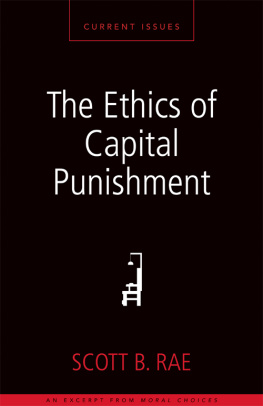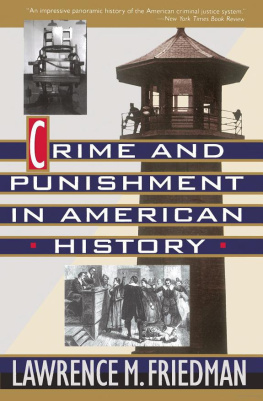David V. Baker - Women and Capital Punishment in the United States: An Analytical History
Here you can read online David V. Baker - Women and Capital Punishment in the United States: An Analytical History full text of the book (entire story) in english for free. Download pdf and epub, get meaning, cover and reviews about this ebook. year: 2015, publisher: McFarland, genre: History. Description of the work, (preface) as well as reviews are available. Best literature library LitArk.com created for fans of good reading and offers a wide selection of genres:
Romance novel
Science fiction
Adventure
Detective
Science
History
Home and family
Prose
Art
Politics
Computer
Non-fiction
Religion
Business
Children
Humor
Choose a favorite category and find really read worthwhile books. Enjoy immersion in the world of imagination, feel the emotions of the characters or learn something new for yourself, make an fascinating discovery.
- Book:Women and Capital Punishment in the United States: An Analytical History
- Author:
- Publisher:McFarland
- Genre:
- Year:2015
- Rating:4 / 5
- Favourites:Add to favourites
- Your mark:
- 80
- 1
- 2
- 3
- 4
- 5
Women and Capital Punishment in the United States: An Analytical History: summary, description and annotation
We offer to read an annotation, description, summary or preface (depends on what the author of the book "Women and Capital Punishment in the United States: An Analytical History" wrote himself). If you haven't found the necessary information about the book — write in the comments, we will try to find it.
David V. Baker: author's other books
Who wrote Women and Capital Punishment in the United States: An Analytical History? Find out the surname, the name of the author of the book and a list of all author's works by series.
Women and Capital Punishment in the United States: An Analytical History — read online for free the complete book (whole text) full work
Below is the text of the book, divided by pages. System saving the place of the last page read, allows you to conveniently read the book "Women and Capital Punishment in the United States: An Analytical History" online for free, without having to search again every time where you left off. Put a bookmark, and you can go to the page where you finished reading at any time.
Font size:
Interval:
Bookmark:


McFarland & Company, Inc., Publishers
Jefferson, North Carolina
LIBRARY OF CONGRESS CATALOGUING DATA ARE AVAILABLE
BRITISH LIBRARY CATALOGUING DATA ARE AVAILABLE
e-ISBN: 978-1-4766-2288-0
2016 David V. Baker. All rights reserved
No part of this book may be reproduced or transmitted in any form or by any means, electronic or mechanical, including photocopying or recording, or by any information storage and retrieval system, without permission in writing from the publisher.
Front cover image: La Peine de Mort en Amrique from Le Petit Journal, April 9, 1899 Look and Learn
McFarland & Company, Inc., Publishers
Box 611, Jefferson, North Carolina 28640
www.mcfarlandpub.com
For my son, Jeremy David Baker.
No father is more proud!
Pulitzer Prize winning author Louis Studs Terkel often commented, Theres no yesterday in this country. Terkels frequent observation is singularly instructive to understanding the contextual history of American women and capital justice. Scholars have afforded scant attention to gender issues in capital sentencing with most investigators narrowly constructing inquiries on gender and capital justice to the postGregg periodcommonly known as the modern era of capital punishment. Consequently, the extant literature offers little in the way of comprehensive studies on the historical contexts of systemic oppression in female capital justice. Few scholars have linked the atrocities committed against women by contemporary justice practitioners to corresponding forms of maltreatment experienced by women in the centuries of gender oppression preceding the modern era in capital justice. In this regard, one researcher is misguided when she writes, Since colonial times there have been numerous studies developed which focus on the execution of women. Certainly some scholarship has outlined the historical evolution of women and capital sentencing, but there are no publications that specifically chronicle the execution of American women while emphasizing the contexts of the penaltys history to women as an artifact of gender oppression. In all likelihood, the lack of historical and contextual discussions on female executions stem from womens executions not comprising a large enough population to justify their independent study. Yet, as one commentator suggests, to fully understand the history of women in our criminal justice system, we need to look at women who have been given the death penalty and at the circumstances surrounding their sentencing and deaths.
To recognize the social, political, and economic contexts in which justice officials have put women to death, the present work furthers understanding of the intersection of capital justice and systemic gender oppression by examining the contextual history of American female executions. The historical record makes clear that challenging the patriarchal repression of women accentuates female executions in the United States. That is, female executions are a consequence of womens economic deprivation, social vulnerability, and political powerlessness in United States society. Poor and marginalized bonded servants and slaves typify most women executed historically. Social outcasts convicted of witchcraft, infanticide, spousal murder and predatory killings accent white women executions. In contrast, mostly slaves and domestic workers convicted of murdering oppressive slave masters, mistresses, overseers, employers and destroying the ill-gotten gains of white masters property derived from slave repression accent black female executions. Similar demographics distinguish the execution of American Indian and Mexican women. One of the more enduring features of capital justice in the United States is that the social attributes of women executed in more modern eras correspond closely to women executed in earlier periods in the history of American capital justice. Today, though executed females are no longer servants and slaves, executed women remain largely social outcasts marginalized by poverty, sexual orientation, extreme drug and alcohol addiction, and severe psychological and psychiatric afflictions resulting from their violent victimization as children and young adults.
The history of executed women is largely unknown, ignored, and discounted. An objective of this book then is to bring voice to this forgotten population victimized by the interlocking systems of race, gender, and class oppression in American capital justice. The study of executed women is important because the master narrative on judicial killings has focused on men to the virtual exclusion of women, rendering the historical picture of capital punishment in the United States incomplete and distorted. To correct for this unfinished portrait of American executions, the present work provides a historical and contextual narrative on the population of executed women. To that end, the discussions that follow do not adopt a comparative analysis with a contextual history of male executions because to compare womens experience to mens experience in the context of capital punishment would be comparing apples to oranges since men and women are not similarly situated in the patriarchal order of American society. Besides, the scholarly literature abounds with understanding the complexities of male judicial killings. The present work moves beyond an accounting of women executed in the United States and includes discussions on the historical contours of condemned women granted executive clemency, women given judicial commutations, an inquiry into women falsely convicted of potentially capital cases, and a profile of the current female death row population.
With these concerns at the forefront of understanding the contextual history of American women and capital justice, the book spans 10 chapters over four parts. Part I explores the theoretical and empirical frameworks accenting the investigation of women and capital punishment in the United States. Research on the capital sentencing of American women lacks a coherent theoretical structure appropriate to explaining the historical realities of gender oppression. To fill this void in the research record, the first chapter provides a brief examination of the extant yet defective theories on women executions and puts forth the notion that the chivalry, evil woman, and equality frameworks are incompatible with the objective historical reality of female executions in this country. Essentially, these theories are flawed because they ignore the patriarchal order of American society accenting white male domination and female subordination. In this regard, the theories overlook the idea that the criminal justice system is the enforcement arm of the American patriarchal order. The chapter puts forward a critical perspective as an alternative explanation on the history of women and capital punishment. From a critical perspective on female executions, imposition of the death penalty is a historically based device designed to control women who directly challenge the white male-controlled structure of American society. The chapter also explains that the U.S. Supreme Court has overlooked gender inequities in capital sentencing and has failed to implement practical protections to ensuring adequate funding of indigent defense services, restraining the discretion and blatant lawlessness of state prosecutors in marginalizing female capital defendants, protecting insane women and women with intellectual disabilities from execution, and prohibiting judicial override of biased judges in female capital cases.
Next pageFont size:
Interval:
Bookmark:
Similar books «Women and Capital Punishment in the United States: An Analytical History»
Look at similar books to Women and Capital Punishment in the United States: An Analytical History. We have selected literature similar in name and meaning in the hope of providing readers with more options to find new, interesting, not yet read works.
Discussion, reviews of the book Women and Capital Punishment in the United States: An Analytical History and just readers' own opinions. Leave your comments, write what you think about the work, its meaning or the main characters. Specify what exactly you liked and what you didn't like, and why you think so.








